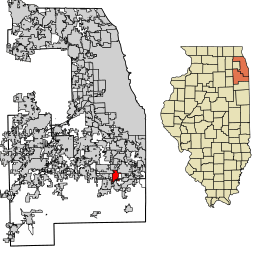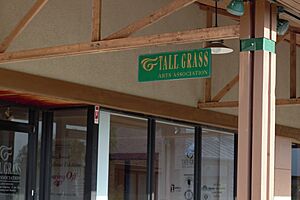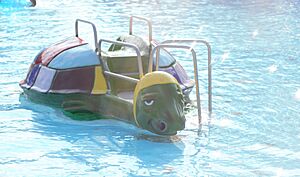Park Forest, Illinois facts for kids
Quick facts for kids
Park Forest, Illinois
|
||
|---|---|---|
|
||
| Motto(s):
"Live Grow Discover"
|
||

Location of Park Forest in Cook and Will Counties, Illinois.
|
||
| Country | United States | |
| State | Illinois | |
| Counties | Cook, Will | |
| Township | Cook: Rich, Bloom Will: Monee |
|
| Area | ||
| • Total | 4.96 sq mi (12.85 km2) | |
| • Land | 4.96 sq mi (12.85 km2) | |
| • Water | 0.00 sq mi (0.00 km2) | |
| Elevation | 712 ft (217 m) | |
| Population
(2020)
|
||
| • Total | 21,687 | |
| • Density | 4,371.50/sq mi (1,687.74/km2) | |
| Time zone | UTC−6 (CST) | |
| • Summer (DST) | UTC−5 (CDT) | |
| ZIP Code(s) |
60466
|
|
| Area code(s) | 708 | |
| FIPS code | 17-57732 | |
Park Forest is a village located south of Chicago in Cook County, Illinois, United States. A small part of it is also in Will County. This village was specially designed as a planned community. It was built for soldiers returning home after World War II.
In 2020, about 21,687 people lived in Park Forest. The village is surrounded by other towns like Olympia Fields and Chicago Heights. Park Forest has many public and private schools. It also has a lively arts scene and lots of fun activities for kids and adults, like the Park Forest Aqua Center.
Contents
History of Park Forest
How Park Forest Began
On October 28, 1946, a group of developers announced their plan to build a new town. This town was called Park Forest. It was designed to be a special community for veterans coming back from World War II. The idea was to create a place where these soldiers and their families could find homes.
After World War II, many people wanted a new way of life. The GI Bill helped soldiers get loans for homes and education. This led to the creation of new suburbs like Park Forest. These new communities offered a different lifestyle than living in big cities.
Awards and Landmarks
Park Forest received a special award in 1954 called "All-America City". This was for how its citizens helped create Rich Township High School. It won this award again in 1976 for being open to people of all races.
A famous place in the village was the Park Forest Plaza. This was a large outdoor shopping center with over 50 stores and restaurants.
Life in Early Park Forest
In the early days, Park Forest was studied by a writer named William H. Whyte. He wrote a book called The Organization Man. This book looked at how people lived in these new suburbs. It showed how many people were starting to work for large companies.
By 1949, Park Forest was a diverse place. It had different community groups and schools. The first African-American family moved to Park Forest in 1959.
Fun Facts and Events
Park Forest is known for its "Scenic 10" race. This is a 10-mile (16 km) running race held every year on Labor Day. In 2008, it was shortened to 5 miles (8 km) and renamed the "Scenic Five".
On March 26, 2003, something amazing happened. A meteor exploded over the Midwest. Dozens of meteorite pieces fell on Park Forest! You can see these pieces at the Field Museum in Chicago. You can learn more about it at Park Forest (meteorite).
Geography and Climate
Where is Park Forest?
Park Forest covers about 4.96 square miles (12.85 square kilometers) of land. It is generally bordered by U.S. Highway 30 to the north and Western Avenue to the east. Central Park Avenue is to the west, and Thorn Creek is to the south.
A railroad line, now called the Canadian National Railway, runs through Park Forest. Part of an old rail line has been turned into a nature trail. This trail is called the Old Plank Trail. It starts at Western Avenue and goes west through Park Forest all the way to Joliet.
Weather in Park Forest
Park Forest has a climate with warm summers and cold winters.
| Climate data for Park Forest, Illinois (1991–2020 normals, extremes 1952–present) | |||||||||||||
|---|---|---|---|---|---|---|---|---|---|---|---|---|---|
| Month | Jan | Feb | Mar | Apr | May | Jun | Jul | Aug | Sep | Oct | Nov | Dec | Year |
| Record high °F (°C) | 65 (18) |
71 (22) |
86 (30) |
89 (32) |
97 (36) |
102 (39) |
102 (39) |
103 (39) |
99 (37) |
91 (33) |
77 (25) |
70 (21) |
103 (39) |
| Mean daily maximum °F (°C) | 31.1 (−0.5) |
35.2 (1.8) |
46.4 (8.0) |
59.3 (15.2) |
70.6 (21.4) |
80.2 (26.8) |
83.9 (28.8) |
82.0 (27.8) |
75.8 (24.3) |
63.1 (17.3) |
48.2 (9.0) |
36.3 (2.4) |
59.3 (15.2) |
| Daily mean °F (°C) | 23.2 (−4.9) |
26.8 (−2.9) |
37.2 (2.9) |
48.8 (9.3) |
60.0 (15.6) |
69.5 (20.8) |
73.9 (23.3) |
72.0 (22.2) |
65.2 (18.4) |
52.8 (11.6) |
39.8 (4.3) |
28.9 (−1.7) |
49.8 (9.9) |
| Mean daily minimum °F (°C) | 15.2 (−9.3) |
18.4 (−7.6) |
28.1 (−2.2) |
38.3 (3.5) |
49.3 (9.6) |
58.9 (14.9) |
63.8 (17.7) |
62.0 (16.7) |
54.6 (12.6) |
42.4 (5.8) |
31.4 (−0.3) |
21.5 (−5.8) |
40.3 (4.6) |
| Record low °F (°C) | −27 (−33) |
−21 (−29) |
−6 (−21) |
9 (−13) |
25 (−4) |
36 (2) |
45 (7) |
41 (5) |
29 (−2) |
17 (−8) |
0 (−18) |
−21 (−29) |
−27 (−33) |
| Average precipitation inches (mm) | 2.49 (63) |
2.15 (55) |
2.65 (67) |
4.02 (102) |
4.57 (116) |
4.91 (125) |
4.73 (120) |
4.02 (102) |
3.44 (87) |
3.65 (93) |
3.00 (76) |
2.47 (63) |
42.10 (1,069) |
| Average snowfall inches (cm) | 10.2 (26) |
7.5 (19) |
4.9 (12) |
0.5 (1.3) |
0.0 (0.0) |
0.0 (0.0) |
0.0 (0.0) |
0.0 (0.0) |
0.0 (0.0) |
0.2 (0.51) |
0.9 (2.3) |
4.0 (10) |
28.2 (72) |
| Average precipitation days (≥ 0.01 in) | 10.6 | 9.0 | 10.2 | 12.1 | 13.1 | 10.4 | 9.4 | 9.1 | 8.3 | 10.5 | 10.1 | 10.7 | 123.5 |
| Average snowy days (≥ 0.1 in) | 5.9 | 4.6 | 2.6 | 0.4 | 0.0 | 0.0 | 0.0 | 0.0 | 0.0 | 0.1 | 0.9 | 3.7 | 18.2 |
| Source: NOAA | |||||||||||||
Getting Around Park Forest
Train Service
You can take a train from Park Forest to downtown Chicago. This service is called Metra. There are stations nearby like Richton Park, 211th Street, and Matteson.
Bus Service
Pace buses also serve Park Forest. They connect the village to many other places in the Southland area.
People of Park Forest
| Historical population | |||
|---|---|---|---|
| Census | Pop. | %± | |
| 1950 | 8,138 | — | |
| 1960 | 29,993 | 268.6% | |
| 1970 | 30,638 | 2.2% | |
| 1980 | 26,222 | −14.4% | |
| 1990 | 24,656 | −6.0% | |
| 2000 | 23,462 | −4.8% | |
| 2010 | 21,975 | −6.3% | |
| 2020 | 21,687 | −1.3% | |
| U.S. Decennial Census 2010 2020 |
|||
In 2020, Park Forest had 21,687 people living there. The village has a diverse population. About 70% of residents were African American, and 19% were White. People of Hispanic or Latino background made up about 7.76% of the population.
The average age in Park Forest was about 39.4 years old. About 22.9% of the people were under 18. The village had about 8,179 households.
| Race / Ethnicity (NH = Non-Hispanic) | Pop 2000 | Pop 2010 | Pop 2020 | % 2000 | % 2010 | % 2020 |
|---|---|---|---|---|---|---|
| White alone (NH) | 12,412 | 6,759 | 3,828 | 52.90% | 30.76% | 17.65% |
| Black or African American alone (NH) | 9,144 | 12,977 | 15,022 | 38.97% | 59.05% | 69.27% |
| Native American or Alaska Native alone (NH) | 34 | 37 | 25 | 0.14% | 0.17% | 0.12% |
| Asian alone (NH) | 188 | 157 | 150 | 0.80% | 0.71% | 0.69% |
| Pacific Islander alone (NH) | 16 | 10 | 9 | 0.07% | 0.05% | 0.04% |
| Other race alone (NH) | 47 | 41 | 131 | 0.20% | 0.19% | 0.60% |
| Mixed race or Multiracial (NH) | 452 | 587 | 840 | 1.93% | 2.67% | 3.87% |
| Hispanic or Latino (any race) | 1,169 | 1,407 | 1,682 | 4.98% | 6.40% | 7.76% |
| Total | 23,462 | 21,975 | 21,687 | 100.00% | 100.00% | 100.00% |
Education in Park Forest
School Districts
Several school districts serve the students in Park Forest. These include:
- Matteson School District 162
- Park Forest Chicago Heights School District 163
- Rich Township High School District 227
- The Rich Township High School District 227 decided to close Rich East High School. Students from there will go to Rich Central and Rich South high schools.
- Crete-Monee School District 201U
Local Schools
Here are some of the schools in Park Forest:
- 21st Century Primary Center
- Michelle Obama School Of Technology And The Arts (Middle School)
- Blackhawk Primary Center
- Mohawk Primary Center
- Illinois School
- Indiana School
- Algonquin Pre-Kindergarten Center
- South Suburban Sda Christian School
- Rich Township High School
- Rich East High School
- Rich South High School
- Rich Central High School
Arts and Culture in Park Forest
The Illinois Theatre Center
The Illinois Theatre Center started in 1976. It offers plays and acting classes for kids, teens, and adults. It moved to Downtown Park Forest in 1999.
Freedom Hall Performing Arts Theatre
Freedom Hall Performing Arts Theatre is a place where you can watch concerts and shows. It has 287 seats. For over 30 years, it has hosted many different types of performances. These include dance, music, and comedy shows. The goal is to bring great cultural events to Park Forest.
Park Forest House Museum
The 1950s Park Forest House Museum lets you step back in time. It's a house built in 1947-1949. It's furnished exactly as it was when the first families lived there from 1948-1953.
You can explore the house and find old dolls, toys, and even clothes from that time. One room even looks like a classroom from the town's very first school. It's a unique way to learn about how people lived after World War II.
Tall Grass Arts Association
The Tall Grass Arts Association is in the Cultural Center in downtown Park Forest. It has an art gallery where artists can show their work. They also hold an annual fine arts fair in September. You can also find art for sale in their gift shop.
Fun and Recreation
Park Forest has many fun things to do for people of all ages. This includes the Park Forest Aqua Center and various park district programs.
Park Forest Aqua Center
The Park Forest Aqua Center has been a popular spot since 1952. You can buy a membership for the whole summer or just a daily pass. It has a special beach pool for toddlers. There's also a 160-foot water slide, two drop slides, and a 15-foot climbing wall. The East Pool is great for swimming laps. Plus, there's a sand area and a snack bar!
The Aqua Center opens in early June and closes on Labor Day. They have special events like Hawaiian Night and Glow Swim. They also offer many swim lesson programs.
Park District Programs
The Park Forest Park District offers many programs throughout the year. These programs are open to everyone, not just residents. They have sports, health and wellness classes, and dance programs. You can also join special day trips and art classes.
Architecture and Design
In 2018, Park Forest was chosen as one of the "Illinois 200 Great Places". This was part of a celebration for Illinois's 200th birthday. The award came from the American Institute of Architects Illinois. It recognized the village's special design and buildings.
Famous People from Park Forest
See also
 In Spanish: Park Forest (Illinois) para niños
In Spanish: Park Forest (Illinois) para niños







